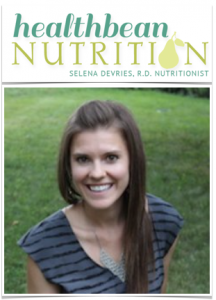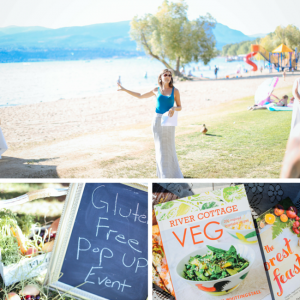Selena De Vries, RD Shares Top 5 Anti-Inflammatory Foods for the Gluten-Free Diet

Selena De Vries, RD
About Selena De Vries, RD
- Selena is a Registered Dietitian living with celiac disease who helps individuals that struggle with digestion find food freedom. At Healthbean Nutrition, Selena understands that celiac disease not only effects our physical health but also effects our emotional health. As such, Selena uses an integrative approach in the management of digestive health conditions. She offers free group support for those with celiac disease/gluten sensitivity as well as offering nutrition coaching for digestive health conditions. Services are offered both online and in the beautiful Okanagan valley.
Congratulations to Selena for her new posting as Director (BC),Canadian Celiac Association (CCA.) She brings with her more than 4 years experience in the medical field as a Registered Dietitian and hopes to put her excellent fundraising skills to use. Thank you, Selena for stepping up to volunteer with the CCA – the national voice for people who are adversely affected by gluten!
Fighting inflammation with food is all the rage right now. Google “anti-inflammatory foods’ and you get over 26,000,000 hits. Wowza!
But in all seriousness, anti-inflammatory foods are really important for celiac disease. Celiac disease is based in a chronic, inflammatory response so fighting inflammation with food (along with supplements at times) is key.
Inflammation can come from certain foods in the diet. The big culprits are foods high in sugar and refined carbohydrates. Many people, especially when first diagnosed, transition to gluten free products that encourage the inflammatory process.
 Gluten free foods that encourage inflammation in the body include:
Gluten free foods that encourage inflammation in the body include:
- Gluten free breads, pasta, baked goods (cakes, cookies, donuts, etc), cereals that are high in starch and white rice content
- Gluten free products high in sugar content such as cereals, bars and granolas and the foods listed above
- Pop
- GF fried foods
- Diets high in red meat
In order to decrease inflammation and encourage healing on the gluten free diet, it is important to decrease the use of the above foods and find healthy, nutritious substitutes. If you need help with this, booking a consultation with a Dietitian with experience in the gluten free diet is important.
Here are my top 5 picks that pack an anti-inflammatory punch:
- Tumeric: This spice is a nutritional powerhouse, quite well known for fighting inflammation. You may see turmeric supplements popping up in many natural food stores. But, your best bet is to always start with the actual food before thinking about supplements.
Supplements can have unwanted side effects at large doses (in pill forms) and may interact with some medications. So, if you are thinking about a turmeric supplement be sure to inform your Registered Dietitian or Medical Doctor.
Try this immune boosting smoothie: Carrot, Ginger Tumeric Smoothie
- Salmon: Salmon is high in omega 3, specifically EPA and DHA, which are potent anti-inflammatory, essential fats that must consumed in the diet to meet our needs. In addition to reducing inflammation, omega 3 fats help to support healthy heart, brain, skin, and bone function.
Try this simple, weeknight meal: Maple Dijon Salmon
- Chia seeds: Chia seeds are a wonderful, vegetarian source of omega 3. The type of omega 3 found in chia seeds is ALA (alpha linolenic acid) and must be metablized into the essential fats EPA and DHA. About 1% of ALA consumed in the diet will be converted into the essential fats, EPA and DHA.
Try this raspberry chia parfait for breakfast
- Green leafy vegetables: There is so much goodness about green leafies (as I like to call them), I could go on and on. They pack a nutritional punch for the gluten free diet. Not only are they anti-inflammatory but they also contain an abundance of b-vitamins, specifically folate which can be deficient in someone with celiac disease. Aim to get a variety of greens throughout the week. Or, switch the type of greens you purchase on a week to week basis. Rotate through dark leafy greens such as romaine lettuce, arugula, kale, swiss chard, collards, red leaf lettuce and more.
Tip: throw a handful into smoothies, gluten free pastas, fried rice, soups, stews, and chilis, top sautéed greens on toast with a drizzle of olive oil and goat cheese, top it fresh on pizzas, etc. The options are endless!
- Blueberries: Blueberries are high in phytonutrients (plant nutrients), antioxidants and flavonoids, all components known to help to reduce inflammation in the body. Blueberries aren’t the only berry rich in these components, though, many other berries (especially dark berries like blackberries) are too.
Try these gluten free blueberry muffins!
Living in the Okanagan or anywhere in British Columbia? View Selena’s services or book an appointment!
- Contact Selena for in-person or on-line support
- HealthBean.ca • Facebook • Twitter • Instagram • Pinterest • Videos • Blog
- [email protected] • 1-778-990-6047
Testimonial
- “I contacted Selena when I still wasn’t feeling well a year after my celiac diagnosis. I’d read so much on the Internet I thought I knew everything I needed to know. I was wrong.
- Selena has important advice on how to do GF properly (it’s not as straightforward as I thought) and for regaining your health. She is organized, punctual, and professional. And she has celiac disease herself , so she gets it.
- I think a lot of us, by the time we’re diagnosed, have had more than our share of health care practitioners and may not want to bother with a dietitian.
- Selena played a crucial role in my recovery, and I would highly recommend her, whether you’re newly diagnosed or just trying to feel better.”
- ~ Charlene (long-distance celiac disease client)
- HEALTHBEAN NUTRITION specializes in digestive health. We deliver easy to digest, bite-size pieces of information so our clients can, finally, achieve the healthy & happy digestive system they’ve been striving for. Learn more ...
- HEALTHBEAN PHILOSOPHY– Selena employs elimination diets and/or a specific diets in accordance with her clients’ conditions, and only when deemed necessary. She reserves advice about the gluten-free diet for those who require it – not those choosing to follow the diet as a lifestyle choice. Expect clear, concise instructions on the appropriate diet for you and, maybe even some myth busting! Learn more …
Selena knows first-hand how her undiagnosed celiac disease affected her physical and emotional health. After telling her that, “Well, you have celiac disease,” her MD suggested she, “google the diet,” and out the door she went. Sound familiar?
That’s why Selena established Healthbean Nutrition. She is dedicating her education, personal insights and her own recovery to helping her fellow celiacs make this enormous lifestyle transition – and find joy in eating again! Learn more …
Selena’s Road to Diagnosis
- “When I was going through university, I was exhausted, ALL the time. I had to drag myself out to hang out with friends, and if I had it my way I would have spent most days in bed sleeping. It was not unknown for me to sleep 12-16 hours a day. Call me crazy, but I related it all to the busy-ness of school. I was even checked for anemia at one point (common with celiacs) and I was ‘fine.’
- The symptoms continued through school and the brain fog was undeniable. I distinctly remember during my dietetic internship (like a medical residency except everything is nutrition based) at Kelowna General Hospital sitting in the office, charting on a patient and, literally, feeling like my brain was so fuzzy that I could barely keep my eyes from nodding off. It was awful.
- Another thing I didn’t pay much attention to, was bowels. I was always constipated. Never the other way around. Never. And, I also remember mentioning this to my gastroenterologist just before the endoscopy and he said ‘oh, well with your very low antibody levels and constipation, there is a very low chance that you are actually celiac but we will proceed with the endoscopy since you’re prepped and ready to go.’
- The piece of paper I received after the endoscopy said to follow up with my GP. I did follow up with my GP and the report came back positive for celiac disease. My GP said “well, you’re celiac. But, you’re a dietitian, right, so this should be easy for you!”
- Perhaps I had a leg up in the nutrition part of it, but I think we all know that the gluten free diet is not a walk in the park. And, although, I am so appreciative of the medical care I received, it did open my eyes to the lack of knowledge within the medical community when it came to celiac disease and the lack of support offered to individuals with celiac disease.
That’s how Healthbean Nutrition was born!
Leave a comment at the bottom of the page.
- *Information and perspectives posted on The Celiac Scene are intended to provide general information, without independent verification on the part of The Celiac Scene for the accuracy of the information provided to it. The information is specifically not intended to be a substitute for medical diagnosis or treatment by your physician or other health care professional. Always consult your own physician or other health care professionals about any medical questions, diagnosis, or treatment, especially before trying any diet. Healthbean Nutrition does not accept any liability for any injury, loss or damage incurred by use of or reliance on any content contained herein.















